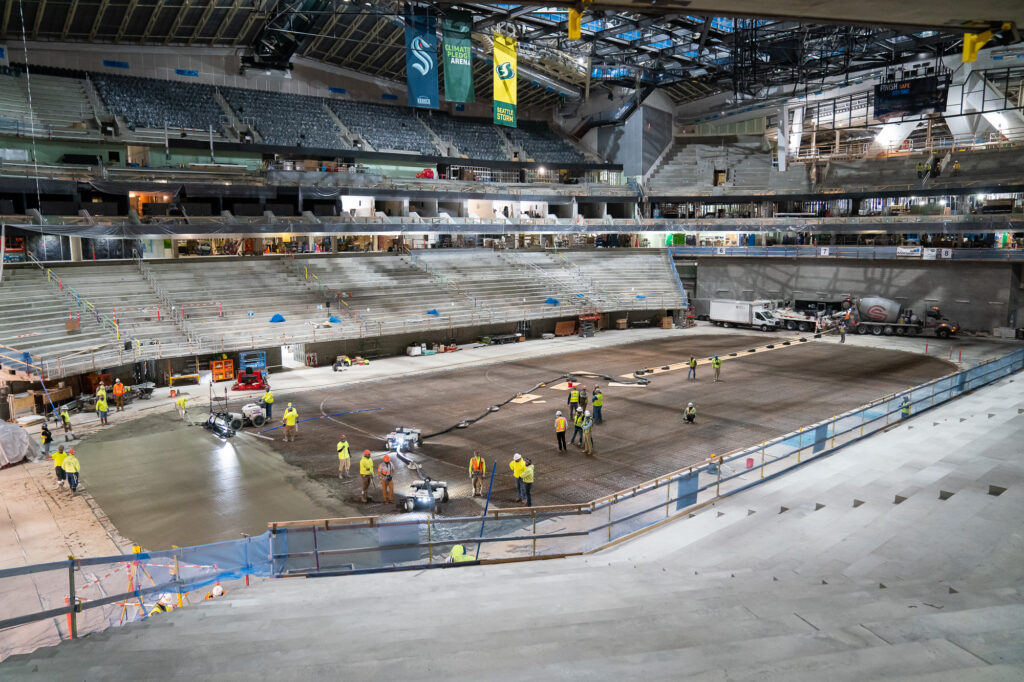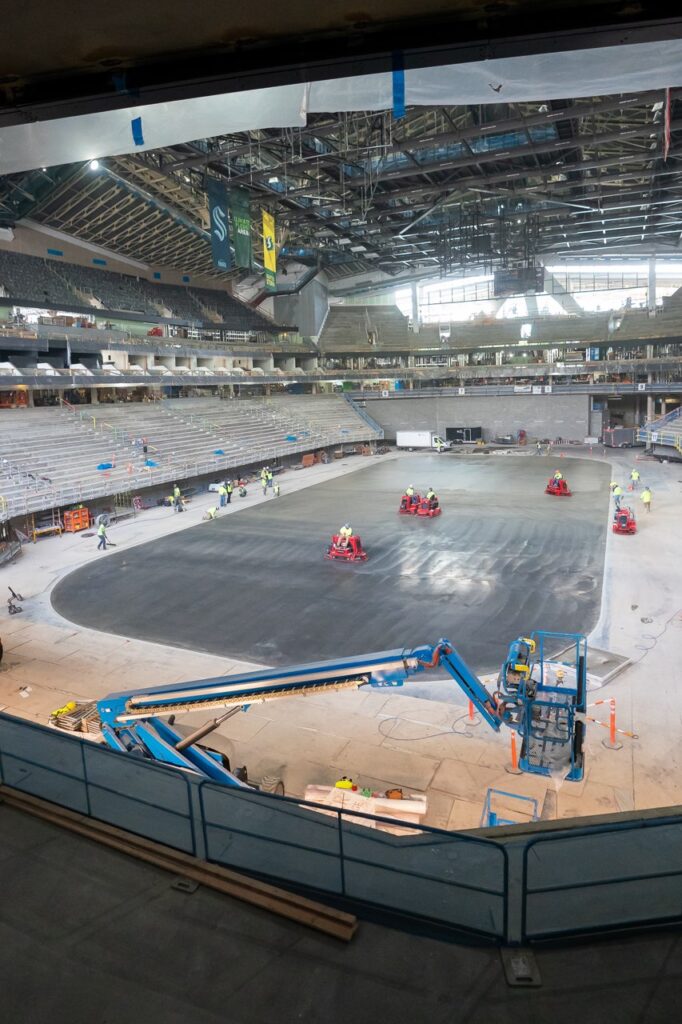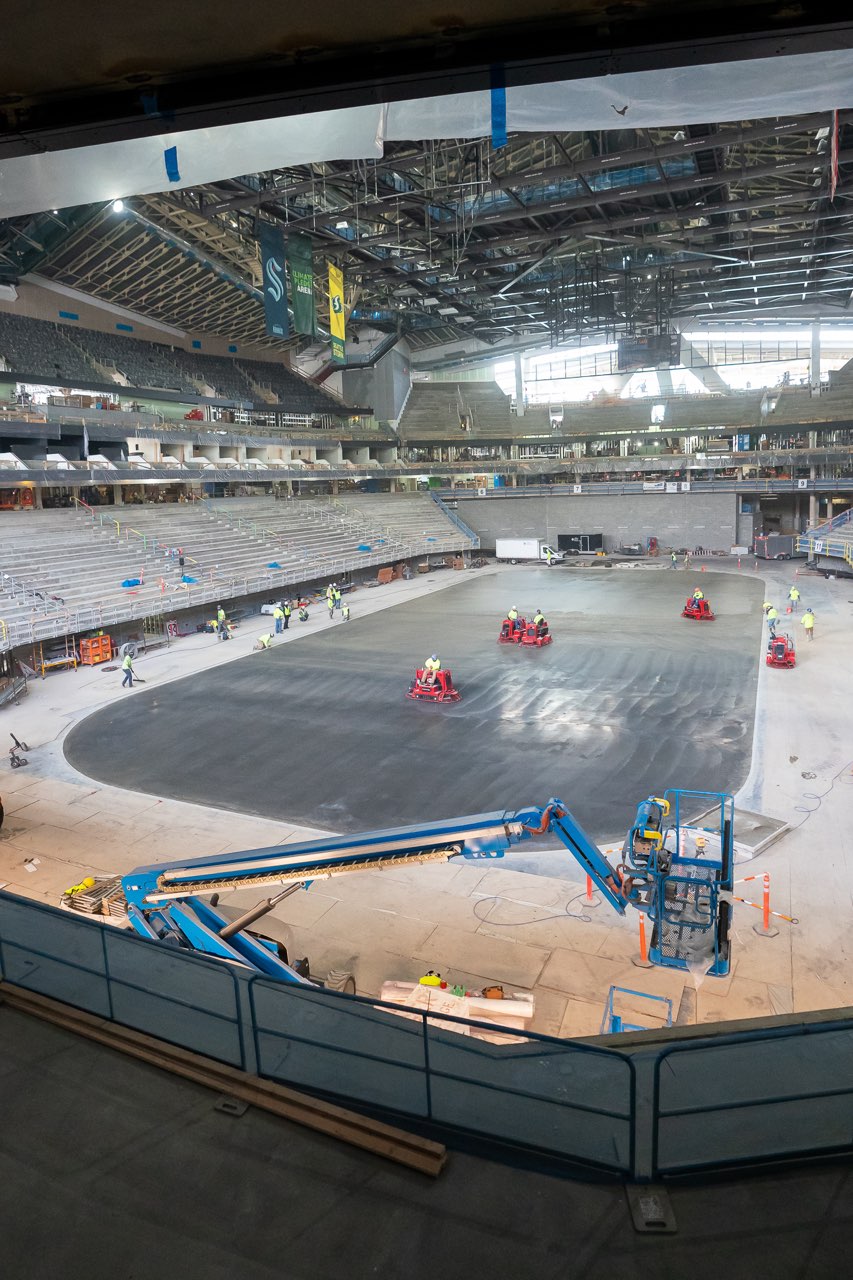The mood at Climate Pledge Arena Friday was a mix of joy, wonder, curiosity and concrete during “big milestone” of pouring the ice rink foundation, a giant stride closer to Kraken puck drop
By: Bob Condor

Climate Pledge Arena was abuzz with Kraken fans Friday morning. Those enthusiasts also happen to be among the 1,000-plus construction workers on the job site for Seattle’s brand-new arena due to open this fall.
During their morning work breaks, dozens of workers, standing alone or socially distanced from one another, checked out at the concrete pour for the arena’s ice rink slab, which commenced at 4 a.m. More than 40 trucks rolled in to supply some 400 cubic yards of concrete. The concrete (experts prefer the term to “cement” and, believe me, the specialty crew in action Friday is an expert group) was filling in over the 13 miles of piping that will serve to freeze the ice surface to NHL standards.
Tyrone Thornton, project engineer for Mortenson, Oak View Group’s general contractor partner, was nearing completion of leading his second vital project for Climate Pledge Arena.
“I couldn’t imagine all of the intricate parts of a concrete pour for the ice rink,” said Thornton Friday morning at 10:15 a.m. with the pour down to one last rink-wide strip behind what will be the south hockey goal. “Now I know.”
Thornton’s first gig? Overseeing the creation of a two-way tunnel, big enough for two semi-trailers truck to pass each other, underground beneath the landmark Bressi Garage building on Thomas Street across from the arena’s new front door on the Seattle Center campus. He clearly embraces a challenge—or two.

“For the rink pour, we leaned on a lot of expertise, including Ice Builders, DJ Rosetti, Pellco Construction [Mukilteo-based, Larusso Concrete [Seattle-Portland], Shinn Mechanical [Kent],” said Thornton. “There are a lot of steps to plan and build an ice slab.”
Ken Johnsen, construction executive for Oak View Group and the Kraken, said he walked into the arena’s entry-level upper concourse only to experience immediate goose bumps. Not from the ice chill—that comes later this summer—but realizing the “big milestone” nature of the concrete pour.
“We’ve been on a mission to build the best hockey arena in the country,” said Johnsen. “The guts of that arena is the ice. I talked with Ron Francis [Kraken GM] and told him everybody involved says this is going to be the best ice.”
The ice slab project started April 12 with a smaller concrete pour to define the slab perimeter and shape (200 feet long by 85 feet wide, rounded in the corners to exact NHL standards). Next was leveling the soil, perfecting the sand base and installing a warming floor that sits at the lowest layer.
The warming floor “prevents heaving and provides consistency for the ice floor,” said Elliott Veazey, senior director for CAA ICON, which acts as owner’s representative for Oak View Group. The warming floor helps prevent the 13 miles of piping above it from freezing.
More layers were then installed, including a vapor barrier. Then rebar (a sort of steel caging), then all that intricate piping that included some 1,800 welds for the bends and changes of direction needed to create ideal ice for NHL place.
There was an innovative computer-assisted “orbital” method used for welding the rink piping, fitting for Climate Pledge Arena, which will be the world’s first zero-carbon sports arena/stadium and furthermore required the erection of 72 steel columns to temporarily hold up its 44-million-pound for a year-plus. There were 1,800 welds on the piping the arena’s rink under-workings with zero leaks upon testing.
“We put pressure on the piping starting with 25 psi [pound per square inch] to see if it would hold, watching on monitors,” said Veazey. “Then we filled it with water and increased the pressure to 100 psi and it held for 24 hours. During the rink pour it is at 40 psi. If anything goes wrong, we would see concrete bubbling up, stop the pour and fix it before moving on [there were no such stoppages Friday].”
The concrete pour itself is a fascinating process as small construction vehicles move around a 200-foot pouring line (think big hose) to target the next fill spot while concrete trucks motor in and out of the tunnel that Thornton supervised, parking at the south end of the rink about where a goal judge will light a red light when there is a score.
“Anyone who works in the concrete industry knows, yes, there is a science to it,” says Johnsen. “But there’s an art to it as well. There’s different phases of the concrete settling, making sure you get the mixtures right. We have experts here today, just like we have experts for all parts and phases of this project.”
Case in point Friday: The crew members driving the finishing vehicles or power screed pick the exact to get those machines whirring and moving laterally and diagonally. The lead screed operator steps on the curing concrete as a first test, then gets in the machine to do a test drive, stopping if not quite the right time.
Once powered up, the screeds deplyoy one type of blade to do the magical job of uniformly smoothing and leveling the ice slab surface (vibration helps the later). The final step is changing out the blade for one that “burns” or creates a “hard-trowel” finish that you know is when the top layer shines like glass.
The last step condenses the surface layer to bring up what the crew calls “the cream” or small-aggregate fine sand, keeping the “rocks” of concrete lower down. A flatness and level test is then performed to “measure certain axes, lengths and widths,” said Veazey.
“It’s the greatest milestone of any hockey arena project,” said Veazey. “Like me, the workers [taking a peek at the ice pour] are imagining the floor being placed right now is where the Kraken will be skating when they hoist the Stanley Cup. That is a most fantastic thing to think about.”








